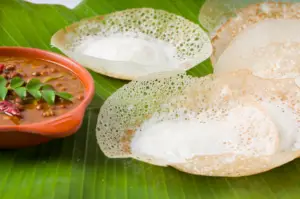Appam, also known as palappam, is a popular and healthy breakfast dish from the Kerala cuisine in South India. These lacy and fluffy pancakes are made from a fermented batter of rice and coconut, resulting in a unique texture and taste.
Appam is a versatile dish that can be enjoyed with a variety of side dishes, but it is traditionally served with vegetable stew for a satisfying vegetarian meal. In this comprehensive guide, we will explore the step-by-step process of making appam from scratch, including tips, variations, and serving suggestions.
Appam is a beloved dish in Kerala, known for its unique shape and softness. It is believed to have been invented by the Jewish Indian community in the Malabar or Kochi region of Kerala. Originally called Kalappam, these pancakes were traditionally fermented with toddy, a local alcoholic drink made from palm or coconut flower. The Jewish community served appam with spicy mutton curry. Over time, the dish became popular among the Christian community as well, who introduced the combination of appam with vegetable stew.
Appam has a bowl-shaped appearance, with a thin and crispy edge and a soft and fluffy center. The fermentation process gives it a slight tanginess and enhances the flavor. The batter is made by grinding soaked rice and grated coconut, resulting in a thin and watery consistency. The combination of rice and coconut creates a perfect balance of flavors and textures, making appam a delightful breakfast option.
Appam Batter: The Key Ingredient
The key ingredient in appam is the batter, which is made from rice and coconut. Here’s a step-by-step guide on how to make the appam batter:
Ingredients:
- 1.5 cups regular rice (like sona masuri, parmal, surti kolam, or ponni rice)
- 2 cups water (for soaking)
- 1/2 cup grated fresh coconut
- 1/4 cup cooked rice
- 1 teaspoon salt
Instructions:
- Rinse the rice in water a few times to remove any impurities.
- Soak the rice in 2 cups of water for 4 to 5 hours, covering the bowl with a lid.
- Drain the water and transfer the soaked rice to a blender or grinder jar.
- Add grated fresh coconut, cooked rice, and salt to the jar.
- Blend or grind the ingredients to a smooth paste, adding water as required. The batter should have a flowing consistency.
- Transfer the batter to a large bowl and mix well.
- Cover the bowl and allow the batter to ferment for 8 to 12 hours, depending on the temperature conditions. The batter should double in volume and have tiny air pockets.
Fermenting the Batter
Fermentation is a crucial step in making appam, as it adds a unique flavor and texture to the pancakes. The fermentation process is achieved by naturally occurring yeast present in the environment or by adding yeast to the batter. Here are two methods for fermenting the appam batter:
Method 1: Natural Fermentation
- After preparing the batter, cover the bowl and let it sit at room temperature for 8 to 12 hours, or until the batter doubles in volume and has a slightly sour smell.
- The fermentation time may vary depending on the temperature conditions. In warmer climates, the batter may ferment faster, while in cooler climates, it may take longer.
- Once the batter has fermented, mix it gently to incorporate the air pockets throughout.
Method 2: Using Yeast
- If you prefer a quicker fermentation process, you can add yeast to the batter.
- Dissolve 1/2 teaspoon of dry active yeast or instant yeast in lukewarm water and let it sit for a few minutes to activate.
- Add the yeast mixture to the batter and mix well.
- Cover the bowl and allow the batter to ferment for 1 to 2 hours, or until it doubles in volume and has plenty of air pockets.
Both methods result in a well-fermented batter, but the natural fermentation process adds a subtle tanginess to the appam.
Making Appam: The Cooking Process
Once the batter has fermented, it is time to cook the appam. Here’s a step-by-step guide on how to make perfect appam:
Ingredients:
- Fermented appam batter
- Appam pan or non-stick pan
- Oil for greasing the pan (optional)
Instructions:
- Heat an appam pan or a seasoned kadai/wok with handles. You can also use a non-stick pan if you don’t have an appam pan.
- If using an appam pan, sprinkle about 1/2 teaspoon of oil on the pan and spread it all over. Skip this step if using a non-stick pan.
- Pour a ladleful of the fermented batter (about 1/4 to 1/3 cup) into the hot pan.
- Immediately, turn and tilt the pan in circular motions to spread the batter and create a round appam. The batter should spread thin towards the edges and have a thicker center.
- If desired, drizzle a few drops of oil around the edges of the appam.
- Cover the pan with a lid and let the appam cook for about 2 minutes, or until the edges turn light golden and crispy, and the center becomes soft and fluffy.
- Gently remove the appam from the pan using a spatula. Repeat the process with the remaining batter to make more appams.
- Serve the appams hot or warm with vegetable stew or your choice of side dish.
Vegetable Stew: The Perfect Accompaniment
Vegetable stew is the traditional accompaniment for appam and complements its flavors perfectly. Here’s how to make a delicious and aromatic vegetable stew:
Ingredients:
- 2 tablespoons coconut oil
- 1/2 inch cinnamon stick
- 3 cardamom pods
- 4 cloves
- 1 teaspoon pepper
- 3 garlic cloves, crushed
- 2 green chilies, slit
- 1 inch ginger, finely chopped
- Few curry leaves
- 4 shallots, halved
- 1 potato, chopped
- 5 beans, chopped
- 1 carrot, chopped
- 3 tablespoons peas
- 1/2 capsicum, chopped
- 1 teaspoon salt
- 3 cups thin coconut milk
- 1 cup thick coconut milk
Instructions:
- Heat coconut oil in a large kadai or pan.
- Add cinnamon, cardamom, cloves, and pepper. Sauté for a few seconds until fragrant.
- Add crushed garlic, green chilies, ginger, curry leaves, and shallots. Sauté until the onions shrink slightly.
- Add chopped potato, beans, carrot, peas, capsicum, and salt. Sauté for 2 minutes, or until the vegetables turn slightly crunchy.
- Pour in the thin coconut milk and mix well.
- Cover the pan and simmer for 10 minutes, or until the vegetables are cooked to your desired tenderness.
- Finally, add the thick coconut milk and give it a gentle stir. Avoid boiling the stew after adding the thick coconut milk to prevent it from splitting.
- The vegetable stew is now ready to be served with appam.
Tips for Perfect Appam
- Use good quality rice for the batter. Sona masuri, parmal, surti kolam, or ponni rice are commonly used varieties.
- Soak the rice for at least 4 to 5 hours to ensure easy grinding and fermentation.
- Use freshly grated coconut for the best flavor. If fresh coconut is not available, you can use frozen grated coconut.
- For a quicker fermentation process, you can add yeast to the batter. Dry active yeast or instant yeast can be used.
- Adjust the consistency of the batter by adding water or rice flour as needed. The batter should be thin and flowing.
- Grease the appam pan lightly with oil before pouring the batter to prevent sticking.
- The pan should be hot enough to spread the batter easily but not too hot to burn it. Adjust the heat accordingly.
- Covering the pan with a lid while cooking helps to cook the appam evenly and create the perfect texture.
- Serve the appam immediately after cooking for the best taste and texture.
Variations of Appam
While the traditional appam recipe is made with rice and coconut, there are a few variations you can try to add a twist to this classic dish:
- Wheat Appam: Replace a portion of the rice with wheat flour or whole wheat atta for a healthier version of appam.
- Ragi Appam: Add ragi (finger millet) flour to the batter for a nutritious and gluten-free appam.
- Egg Appam: Break an egg into the center of the appam while it is cooking to create a delicious and protein-rich variation.
- Neer Appam: Make a thinner version of appam by using more water in the batter. Neer appam is a popular dish in Karnataka.
- Jaggery Appam: Add jaggery or palm sugar to the batter for a sweet version of appam. It can be enjoyed as a dessert or snack.
Feel free to experiment with different ingredients and flavors to create your own unique appam recipes.
Serving Suggestions
Appam is a versatile dish that can be enjoyed with a variety of side dishes. Here are a few serving suggestions to enhance your appam experience:
- Vegetable Stew: The classic combination of appam and vegetable stew is a match made in culinary heaven. The creamy and aromatic stew perfectly complements the soft and fluffy appam.
- Kadala Curry: This spicy chickpea curry is another popular side dish for appam. The combination of the rich and flavorful curry with the delicate appam is a treat for your taste buds.
- Coconut Chutney: If you prefer a lighter accompaniment, serve appam with coconut chutney. The fresh and tangy flavors of the chutney add a refreshing element to the dish.
- Potato Stew: A simple and comforting potato stew can also be served with appam. The creamy and mildly spiced stew pairs well with the delicate flavors of appam.
- Meat Curries: If you are a non-vegetarian, you can enjoy appam with spicy meat curries like chicken, mutton, or fish. The combination of the flavorful curries and soft appam is a feast for meat lovers.
Feel free to explore different combinations and create your own favorite combinations based on your preferences.
Frequently Asked Questions (FAQs)
Q1: Can I make appam without fermenting the batter? A1: Fermentation is an important step in making appam as it contributes to the unique texture and taste. However, if you are in a hurry, you can use instant appam mix available in the market, which requires minimal or no fermentation.
Q2: Can I use store-bought coconut milk instead of fresh coconut? A2: Freshly grated coconut is preferred for the authentic flavor of appam. However, if fresh coconut is not available, you can use store-bought coconut milk. Opt for unsweetened and thin coconut milk for the batter and reserve the thick coconut milk for the vegetable stew.
Q3: Can I make appam batter in advance? A3: Yes, you can prepare the appam batter in advance and store it in the refrigerator for up to 2 days. However, it is best to use the batter within 24 hours for optimal results.
Q4: How many appams can I make with this recipe? A4: The number of appams you can make depends on the size of the pan and the amount of batter used for each appam. Typically, you can make around 15 appams with the given quantities in this recipe.
Q5: Can I freeze appam batter? A5: It is not recommended to freeze the appam batter as it may affect the fermentation process and texture of the appams. It is best to prepare fresh batter when needed.




